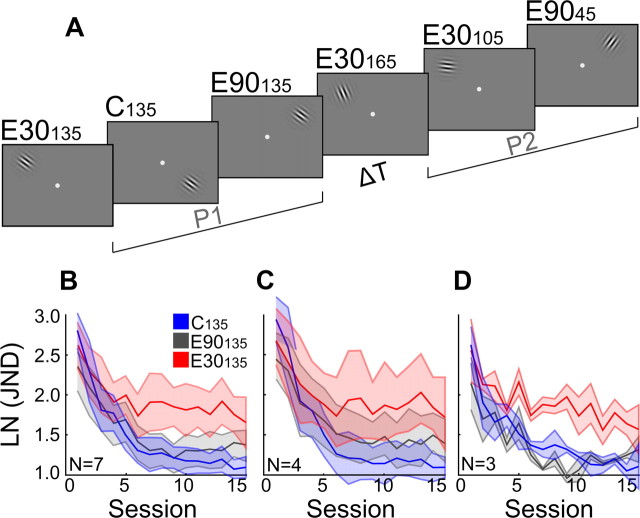Figure 6.
Double training does not cause behavioral interference. A, Experimental design used to replicate interfering effects of two blocks of training in P2 at reference orientations that differ by 30° from 135° (C30135 in P1, E30105 and E30165 in P2), and to compare these with interfering effects of a single block or two blocks in P2 at a reference orientation differing by 90° from 135° (E90135 in P1, E9045 in P2). Thus, while each stimulus display in Figure 6A corresponds to four JNDs, display E9045 was tested in either four or eight JNDs. The number following “E” refers to the orientation difference between reference orientations used during P1 and P2 training in the same location. B, Training in orientation discrimination with orthogonal reference orientations during P1 and P2 does not cause behavioral interference (N = 7). The figure shows learning curves for P1 training at the 135° reference orientation in the control quadrant (C135), for P1 training at the 135° reference orientation in the experimental quadrant where P2 training was performed with an orthogonal 45° reference (E90135) (either 4 or 8 JNDs), and for P1 training at the 135° reference orientation in the experimental quadrant where P2 training was performed at ±30° references (E30135). Learning curves for E90135 (dark gray) and C135 (blue) overlap. C, Effect of training with a double block (8 JNDs) of P2 training at a 45° reference (E9045) on learning rate in the preceding P1 training condition at 135° (E90135). D, Effect of training with a single block (4 JNDs) of P2 training at a 45° reference (E9045) in otherwise the same experiment. In both datasets, the E90135 condition (dark gray line) is compared with the standard control condition C135 (blue line), and with the standard interference condition E30135 (red line) in which P1 training at 135° was followed by a block (4 JNDs) of P2 training at 105° and a block at 165. A repeated-measures ANOVA [Double-Training (yes, no) × Condition (C135, E90135) × Session (15)] showed that neither the main effect of Condition (F(1,5) = 0.95, p = 0.770) nor the Condition × Double-Training interaction (F(1,5) = 2.946, p = 0.147) was significant.

